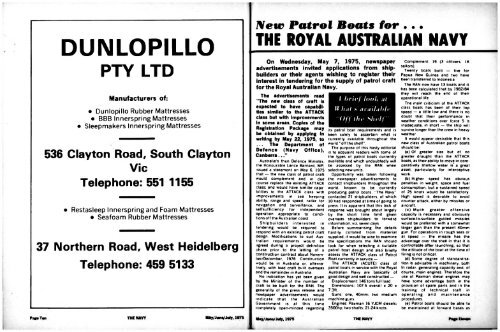The Navy Vol_37_Part1 (Feb-Mar-Apr, May-June-July 1975)
The Navy Vol_37_Part1 (Feb-Mar-Apr, May-June-July 1975)
The Navy Vol_37_Part1 (Feb-Mar-Apr, May-June-July 1975)
- No tags were found...
You also want an ePaper? Increase the reach of your titles
YUMPU automatically turns print PDFs into web optimized ePapers that Google loves.
DUNLOPILLOPTY LTDManufacturers of:• Dunlopillo Rubber Mattresses• BBB Innerspring Mattresses• Sleepmakers Innerspring Mattresses536 Clayton Road, South ClaytonVicTelephone: 551 1155• Restasleep Innerspring and Foam Mattresses• Seafoam Rubber Mattresses<strong>37</strong> Northern Road, West HeidelbergTelephone: 459 5133Pac*T«i THE NAVY <strong>May</strong>/JunV<strong>July</strong>. 1973New Patrol Boats for . • •THE ROYAL AUSTRALIAN NAVYOn Wednesday, <strong>May</strong> 7, <strong>1975</strong>, newspaperadvertisements invited applications from shipbuildersor their agents wishing to register theirinterest in tendering for the supply of patrol craftfor the Royal Australian <strong>Navy</strong>.<strong>The</strong> advertisements read'<strong>The</strong> new class of craft isexpected to have capabilitiessimilar to the ATTACKclass but with improvementsin some areas. Copies of theRegistration Package maybe obtained by applying inwriting by <strong>May</strong> 22, <strong>1975</strong>, to... <strong>The</strong> Department ofDefence (<strong>Navy</strong> Office),Canberra..Australia's then Defence Minister,the Honourable Lance Barnard. MP.issued a statement on <strong>May</strong> 6. <strong>1975</strong>that — the new class of patrol craftwould complement and in duecourse replace the existing ATTACKclass: and would have similar capabilitiesto the ATTACK class withimprovements in sea keepingability, range and speed, radar fornavigation and surveillance, andselfsufficiency for independentoperation appropriate to conditionsoff the Australian coast.Shipbuilders interested intendering would be required torespond with an existing patrol craftdesign. Modifications to suit Australianrequirements wou'd beagreed during a project definitionphase prior to the letting of aconstruction contract about November/December.1976. Constructionwould be in Australia or. alternatively.with lead craft built overseasand the remainder in Australia.No indication has yet been givenby the Minister of the number ofcraft to be built for the RAN. <strong>The</strong>generality of the press release andnewspaper advertisements wouldindicate that the AustralianGovernment is at this timecompletely open-minded regarding1 brief look ;it11 hut n nrnil.ihli•"Off the Shelfits patrol boat requirements and iskeen solely to ascertain what iscurrently available throughout theworld "off the shelf".<strong>The</strong> purpose of this hasty editorialis to acquaint readers with some ofthe types of patrol boats currentlyavailable and which undoubtedly willbe assessed by the RAN whenselecting new units.Opportunity was taken followingthe newspaper advertisements tocontact shipbuilders throughout theworld, known to be currentlyproducing patrol boats. "<strong>The</strong> <strong>Navy</strong>"contacted 21 shipbuilders, of which10 had responded at time of going topress. It is apparent that this lack ofresponse was brought about largelyby the short time limit givenoverseas shipbuilders to forwardinformation, viz. seven days.Before summarising the detailshastily collated from materialsupplied, it would be wise to examinethe specifications the RAN shouldlook for when selecting a suitablepatrol boat design and also brieflyassess the ATTACK class of PatrolBoat currently in service —<strong>The</strong> ATTACK (ACUTE) class ofpatrol boats in service with the RoyalAustralian <strong>Navy</strong> are basically ofgood design and well constructed —Displacement: 146 tons full load.Dimensions: 107.5 overall x 20 x7.3ft.Guns: one. 40mm: two mediummachine guns.Engines: Paxman 16 YJCM diesels:3500hp; two shafts: 21-24 knots.Complement: 19 (3 officers. 16sailors).Twenty boats built — five forPapua New Guinea and two havebeen transferred to Indonesia.<strong>The</strong> RAN now have 13 boats and ithas been calculated that by 1982/84they will reach the end of theiroperational life.<strong>The</strong> main criticism of the ATTACKclass boats has been of their topspeed — a little low and there is nodoubt that their performance inweather conditions over force 5 isinadequate, in short — the ship willsurvive longer than the crew in heavyweather.It would appear desirable that thisnew class of Australian patrol boatsshould be:(a) Of greater size but of nogreater draught than the ATTACKboats, as their ability to move in comparativelyshallow water is* a greatasset, particularly for interceptivework.(b) Higher speed has obviouspenalties in weight, space and fuelconsumption, but a sustained speedof 25 knots would be satisfactory.High speed is desirable to avoidcounter attack, either by missiles oraircraft.(c) Much greater offensivecapacity is necessary and obviouslysurface-to-surface guided missileswould be preferred with a somewhatlarger gain than the present 40mmgun. For operations in rough seas orat speed — the missile has theadvantage over the shell in that it iscontrollable after launching, so thatthe attitude of the boat at the time offiring is not critical.(d) Some degree of standardisationis advisable in machinery, bothIn radar, generating capacity and. ofcourse, main engines. <strong>The</strong>refore theuse of Paxman diesel engines mayhave some advantage both in theprovision of spare parts and in thetraining of technical staff inoperating and maintenanceprocedures.(e) Patrol boats should be able tobe maintained at forward bases as<strong>May</strong>/<strong>June</strong>/<strong>July</strong>, <strong>1975</strong> THE NAVY P«C« Eleven
















